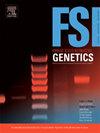DNAStatistX在实验室环境下的校准性能和对似然比阈值的考虑
IF 3.1
2区 医学
Q2 GENETICS & HEREDITY
引用次数: 0
摘要
之前的一项研究检查了校准和判别性能,强调了在解释基于最大似然估计的DNAStatistX和EuroForMix[1]模型得出的“低”似然比(LRs)时需要谨慎。该研究报告了校准性能取决于数据集,数据集大小和亚种群校正因子(Fst)。在最坏的情况下(最小的数据集和Fst 0.01), LRs的误校准发生在LR ~ 1000。在最好的情况下(最大的数据集和Fst 0.03),校正误差的迹象高达LR ~ 100,但不高于LR。在目前的研究中,我们使用一个更能反映我们的案例实践的数据集来检验DNAStatistX的识别能力和校准性能。这包括在LR计算中使用两种不同的分析阈值设置和多达三个PCR复制谱来分析PowerPlex®Fusion 6C数据。结果表明,校准性能与基于最大似然(MLE)模型的先前发现相当或更好。使用两组不同的分析阈值产生了类似的结果。当在LR计算中合并重复剖面时,校准性能下降。此外,本研究表明,使用每个染料的LRs来评估校准性能可能是有益的,特别是当数据集大小有限时。总的来说,这些发现支持了之前的研究,表明在使用基于mle的模型时,设置较低的报告阈值是有用的。理想情况下,阈值越低越好,这样可以避免忽略有价值的证据。数据似乎支持LR值1000。本文章由计算机程序翻译,如有差异,请以英文原文为准。
Calibration performance of DNAStatistX in a laboratory setting and considerations for likelihood ratio thresholds
A previous study examining calibration and discrimination performance highlighted the need for caution when interpreting “low” likelihood ratios (LRs) derived from maximum likelihood estimate-based models DNAStatistX and EuroForMix [1]. The study reported that calibration performance was dependent on the dataset, dataset size and the subpopulation correction factor (Fst). In the worst case scenario (smallest dataset and Fst 0.01) miscalibration of LRs occurred up to LR ∼1000. In the best case scenario (largest dataset and Fst 0.03) there were signs of miscalibration up to LR ∼100 but not above. In the current study, the discrimination power and calibration performance were examined for DNAStatistX using a dataset that more closely reflects our casework practice. This involved analysing PowerPlex® Fusion 6C data using two different analytical threshold sets and up to three PCR replicate profiles in the LR calculation. The results showed calibration performance that was comparable or better than previous findings for maximum likelihood based (MLE) models. The use of two different sets of analytical thresholds yielded similar results. Calibration performance decreased when replicate profiles were combined in the LR calculation. Additionally, this study demonstrates that using per-dye LRs to assess calibration performance can be beneficial, especially when the dataset size is limited. Overall, the findings support previous research, suggesting that setting a lower threshold for reporting is useful when using MLE-based models. Ideally, the threshold is as low as possible as that may avoid overlooking valuable evidence. An LR value of 1000 seems supported by the data.
求助全文
通过发布文献求助,成功后即可免费获取论文全文。
去求助
来源期刊
CiteScore
7.50
自引率
32.30%
发文量
132
审稿时长
11.3 weeks
期刊介绍:
Forensic Science International: Genetics is the premier journal in the field of Forensic Genetics. This branch of Forensic Science can be defined as the application of genetics to human and non-human material (in the sense of a science with the purpose of studying inherited characteristics for the analysis of inter- and intra-specific variations in populations) for the resolution of legal conflicts.
The scope of the journal includes:
Forensic applications of human polymorphism.
Testing of paternity and other family relationships, immigration cases, typing of biological stains and tissues from criminal casework, identification of human remains by DNA testing methodologies.
Description of human polymorphisms of forensic interest, with special interest in DNA polymorphisms.
Autosomal DNA polymorphisms, mini- and microsatellites (or short tandem repeats, STRs), single nucleotide polymorphisms (SNPs), X and Y chromosome polymorphisms, mtDNA polymorphisms, and any other type of DNA variation with potential forensic applications.
Non-human DNA polymorphisms for crime scene investigation.
Population genetics of human polymorphisms of forensic interest.
Population data, especially from DNA polymorphisms of interest for the solution of forensic problems.
DNA typing methodologies and strategies.
Biostatistical methods in forensic genetics.
Evaluation of DNA evidence in forensic problems (such as paternity or immigration cases, criminal casework, identification), classical and new statistical approaches.
Standards in forensic genetics.
Recommendations of regulatory bodies concerning methods, markers, interpretation or strategies or proposals for procedural or technical standards.
Quality control.
Quality control and quality assurance strategies, proficiency testing for DNA typing methodologies.
Criminal DNA databases.
Technical, legal and statistical issues.
General ethical and legal issues related to forensic genetics.

 求助内容:
求助内容: 应助结果提醒方式:
应助结果提醒方式:


